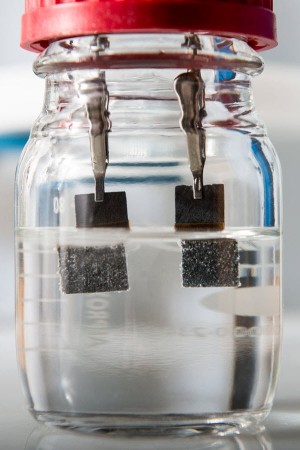June 24, 2015 – One of the knocks against hydrogen fuel cells comes from the way we create hydrogen by burning natural gas. The process is energy intensive and a carbon polluter. But engineers at Stanford University are splitting hydrogen from water using a single catalyst. The byproduct is oxygen.
The result of their experiments appear in the June 23, 2015 issue of Nature Communication. You’ll love the title, “Bifunctional non-noble metal oxide nanoparticle electrocatalysts through lithium-induced conversion for overall water splitting.” Nary a mention of producing hydrogen or oxygen gases. No mention even of the catalytic material the researchers invented. Yet those are the important outcomes of the research, the development of a cheap catalyst that doesn’t use expensive Noble metals and produces hydrogen with significant commercial implications. That’s one of my bugbears about academic research. Scientists and engineers need to learn “plain speak” if they are to get their message across to the lay public. Too often you get titles like the one above which “buries the lead” as we say in journalism.
But I digress. The discovery made by the researchers is a vast improvement and simplification of electro-catalysis. Where conventional water splitters require two electrodes and two electrolytes, one acidic and the other alkaline, this device uses a single catalyst with both electrodes made of the same nickel-iron oxide. With a single 1.56 volt charge the catalyst split water at an 82% efficiency rate at room temperature.
The secret is in the way the researchers chemically broke down the metal oxide into smaller and smaller pieces increasing surface area to dramatically improve conductivity in the catalyst. The end result seen in the bottle below is an inexpensive hydrogen and oxygen production system that the researchers operated continuously for 200 hours. One drawback, after 30 hours, the process required a 40% boost in the power feed demonstrating a loss of efficiency. This is something the researchers hope to minimize in future improvements to the technology.
So what else can this research lead to? It could be a springboard to making catalysts using other metals that produce different chemical fuels beyond hydrogen. That is what the researchers hope will happen. Yet their hydrogen generator has commercial application written all over it.
















